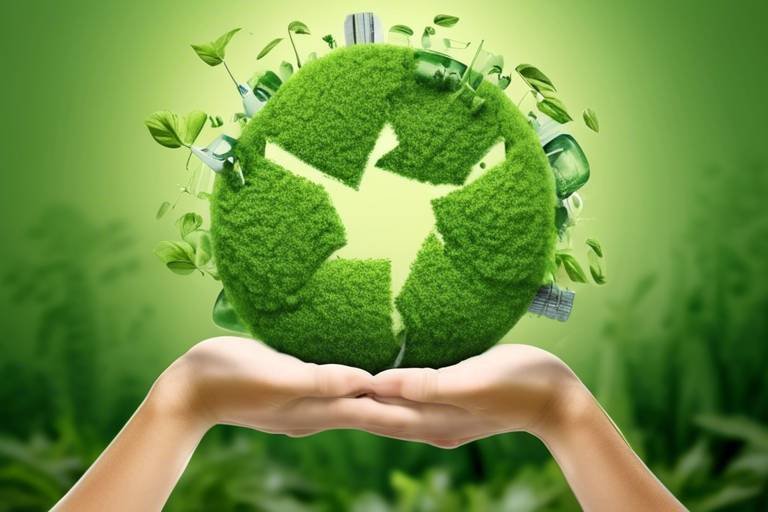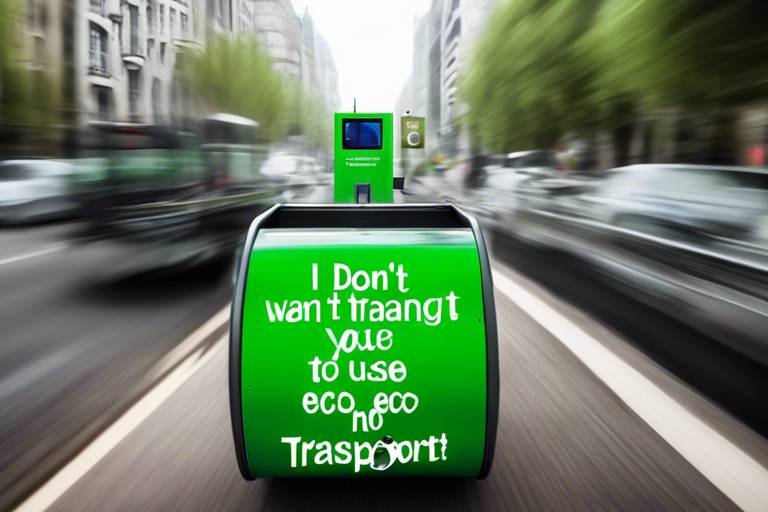Top Eco-Friendly Innovations of 2022
In a world increasingly aware of the environmental challenges we face, 2022 has emerged as a pivotal year for eco-friendly innovations. From groundbreaking renewable energy technologies to sustainable transportation solutions, this year has been nothing short of revolutionary. These advancements not only aim to reduce our carbon footprint but also pave the way for a greener, more sustainable future. As we delve into the innovations of 2022, you'll discover how these technologies are reshaping our planet and our lives. Are you ready to explore the exciting developments that are making waves in sustainability?
One of the most significant shifts in 2022 has been in the realm of renewable energy sources. Innovations in solar, wind, and geothermal energy are transforming how we harness power. For instance, solar panels have become more efficient and affordable, making them accessible to a broader audience. Wind energy has also seen substantial advances, with larger turbines that capture more energy and new offshore wind farms that harness stronger ocean winds. Geothermal energy, often overlooked, is gaining traction as new technologies make it feasible to tap into the Earth's heat even in regions previously deemed unsuitable. These advancements are crucial in our fight against climate change, providing cleaner alternatives to fossil fuels.
Transportation is another area where 2022 has seen remarkable innovations. With urban congestion and pollution on the rise, cities are turning to sustainable transportation solutions that promote cleaner mobility. Electric vehicles (EVs) are leading this charge, with advancements in technology making them more efficient and accessible. But it doesn't stop there. Bike-sharing programs and enhanced public transit systems are also emerging, encouraging people to opt for greener travel methods. Imagine a world where hopping on a bike or a clean, electric bus is as easy as getting in your car. This shift not only reduces emissions but also fosters healthier lifestyles.
The electric vehicle market has exploded in 2022, with several key breakthroughs making headlines. Improved battery efficiency means that EVs can now travel longer distances on a single charge, alleviating range anxiety for potential users. Additionally, the expansion of charging infrastructure is making it easier than ever to own an electric vehicle. Picture this: charging your car while you grab a coffee or run errands. This convenience is crucial for increasing EV adoption and reducing reliance on traditional gasoline-powered vehicles.
As the number of electric vehicles on the road increases, so does the need for effective battery recycling methods. New innovations in battery recycling are emerging, focusing on minimizing waste and recovering valuable materials. This not only helps to reduce environmental impact but also supports a circular economy. By recycling EV batteries, we can recover precious metals like lithium and cobalt, which are essential for future battery production. It's a win-win situation for both the planet and the economy.
Imagine hopping on a self-driving bus that takes you seamlessly to your destination. In 2022, autonomous public transport is becoming a reality. Self-driving shuttles and buses are enhancing public transportation systems, reducing emissions and providing efficient mobility solutions for urban areas. This innovation not only improves accessibility but also reduces the number of vehicles on the road, leading to less congestion and a cleaner environment.
Eco-friendly smart home innovations are also making waves in 2022. These technologies optimize energy use and improve efficiency, contributing to sustainable living practices in households. Smart thermostats, for example, learn your habits and adjust heating and cooling accordingly, saving energy without sacrificing comfort. Additionally, smart appliances can be programmed to run during off-peak hours, further reducing energy consumption. By integrating these technologies into our homes, we can significantly lower our carbon footprint while enjoying modern conveniences.
As the world grapples with the plastic crisis, 2022 has seen a rise in the use of biodegradable materials. These materials are being increasingly utilized in packaging and consumer products, aiming to reduce plastic waste and promote environmental responsibility. Biodegradable packaging breaks down naturally, minimizing its impact on landfills and oceans. Imagine a world where your takeout container decomposes in weeks instead of centuries—this is the future we are striving for.
In line with the shift towards biodegradable materials, the trend of plant-based alternatives is gaining momentum. Industries are exploring ways to replace traditional plastics with sustainable options derived from plants. These materials not only offer a lower ecological impact but also present exciting opportunities for innovation. For instance, packaging made from cornstarch or sugarcane can provide the same functionality as plastic without the environmental toll. It's a game-changer for businesses and consumers alike.
Finally, advancements in waste management technologies are enhancing recycling processes and reducing landfill contributions. In 2022, smart waste bins equipped with sensors are helping cities monitor waste levels in real-time, optimizing collection routes and reducing emissions from garbage trucks. Additionally, new sorting technologies are improving the efficiency of recycling facilities, ensuring that more materials are reused rather than thrown away. These innovations pave the way for a cleaner environment and a more sustainable future.
- What are the most important eco-friendly innovations of 2022? The key innovations include advancements in renewable energy, electric vehicles, biodegradable materials, and smart home technologies.
- How do electric vehicles contribute to sustainability? Electric vehicles reduce reliance on fossil fuels, lower greenhouse gas emissions, and can be powered by renewable energy sources.
- What is the significance of biodegradable materials? Biodegradable materials help reduce plastic waste, which is a significant environmental issue, by breaking down naturally over time.

Revolutionary Renewable Energy Sources
As we venture deeper into the 21st century, the quest for sustainable energy sources has never been more critical. The innovations in renewable energy technologies in 2022 are nothing short of revolutionary, paving the way for a greener future. Imagine a world where our power comes from the sun, wind, and even the heat from the Earth itself! These advancements not only reduce our carbon footprint but also enhance energy efficiency and accessibility.
Let’s start with solar energy. In 2022, we witnessed remarkable improvements in solar panel efficiency. New materials and designs have emerged, allowing solar panels to capture more sunlight and convert it into usable energy. For instance, bifacial solar panels, which can absorb light from both sides, have become increasingly popular. This innovation boosts energy output significantly, making solar power even more attractive for both residential and commercial applications.
Wind energy also saw exciting developments. With the advent of larger and more efficient turbines, wind farms can generate more energy than ever before. These turbines are not only taller but also equipped with advanced technology that allows them to harness wind energy at lower speeds. This means that even in areas with less consistent wind, we can still tap into this powerful resource. According to recent studies, the global wind energy capacity has increased by over 20% in just one year!
Now, let’s not forget about geothermal energy, which is often overshadowed by its solar and wind counterparts. However, 2022 has brought forth innovative geothermal systems that allow us to harness the Earth’s natural heat more efficiently. Enhanced geothermal systems (EGS) are being developed to tap into underground reservoirs, providing a reliable and consistent energy source. This technology has the potential to supply power to entire cities while emitting virtually no greenhouse gases.
In addition to these technologies, the integration of smart grids has revolutionized how we distribute and manage energy. These grids utilize advanced communication technology to monitor and optimize energy flow from renewable sources. By balancing supply and demand in real-time, smart grids enhance the reliability of renewable energy and reduce the need for fossil fuels during peak usage times. It’s like having a personal energy manager that ensures we use our resources wisely!
To illustrate the impact of these renewable energy sources, let’s take a look at the following table showcasing the growth of renewable energy capacity in various sectors:
| Energy Source | 2021 Capacity (GW) | 2022 Capacity (GW) | Growth (%) |
|---|---|---|---|
| Solar | 800 | 1000 | 25% |
| Wind | 750 | 900 | 20% |
| Geothermal | 15 | 20 | 33% |
As we can see, the growth in renewable energy capacity is impressive and indicates a strong shift towards sustainability. The collective efforts in these innovative technologies highlight a crucial point: we have the resources and the technology to create a cleaner, more sustainable future. But the question remains, how can we accelerate this transition? By investing in education, infrastructure, and policies that support renewable energy, we can ensure that these advancements are not just fleeting trends but a permanent shift in how we power our world.
In conclusion, the of 2022 are setting the stage for a sustainable future. With solar, wind, and geothermal technologies leading the charge, we are witnessing a transformation that could redefine our relationship with energy. It’s time for us to embrace these innovations, not just for ourselves but for future generations. After all, every small step towards sustainability counts, and together, we can create a brighter, greener world.
- What are renewable energy sources? Renewable energy sources are natural resources that are replenished over time, such as solar, wind, and geothermal energy.
- How do solar panels work? Solar panels convert sunlight into electricity using photovoltaic cells that generate direct current (DC) when exposed to sunlight.
- What are the benefits of wind energy? Wind energy is clean, renewable, and can significantly reduce greenhouse gas emissions while providing a sustainable power source.
- Is geothermal energy sustainable? Yes, geothermal energy is sustainable as it harnesses the Earth’s natural heat, which is continuously replenished.

Sustainable Transportation Solutions
In a world where urban congestion is becoming a daily challenge, the need for has never been more pressing. Imagine a city where traffic jams are a thing of the past, where the air is cleaner, and where getting from point A to point B doesn't come at the expense of our planet. This vision is becoming a reality thanks to innovative transportation methods that prioritize sustainability and efficiency. From electric vehicles to bike-sharing programs, these advancements are not just trends; they are essential shifts in how we think about mobility.
One of the most exciting developments in this arena is the rise of electric vehicles (EVs). With advancements in battery technology, these vehicles are becoming more efficient and accessible than ever. The latest models boast longer ranges and shorter charging times, making them a practical choice for everyday commuters. Additionally, the expansion of charging infrastructure is making it easier for consumers to adopt this eco-friendly mode of transportation. In fact, many cities are now installing fast-charging stations in convenient locations, ensuring that drivers can recharge their vehicles while they shop or work.
But it's not just about individual car ownership. Public transportation systems are also undergoing a transformation. Autonomous public transport is on the rise, with self-driving buses and shuttles being tested in various urban areas. These vehicles promise to enhance the efficiency of public transit, reduce emissions, and provide a seamless travel experience. Imagine hopping on a bus that knows your route and picks you up right on time, all while minimizing its carbon footprint. This is not science fiction; it’s happening now.
Moreover, the integration of smart technology into public transportation is paving the way for more sustainable urban mobility. For instance, real-time tracking apps allow commuters to plan their journeys more effectively, reducing wait times and optimizing routes. This not only makes public transport more appealing but also encourages more people to leave their cars at home, further alleviating traffic congestion.
Another vital component of sustainable transportation is bike-sharing programs. These initiatives are gaining popularity in cities around the globe, offering an eco-friendly alternative for short-distance travel. With a simple app, users can rent bikes on the go, promoting a healthier lifestyle while reducing reliance on fossil fuels. Cities that have embraced bike-sharing have seen a significant decrease in traffic and pollution levels, proving that sometimes, the simplest solutions can have the most profound impacts.
The shift towards sustainable transportation is not just beneficial for the environment; it also has economic implications. By investing in green transportation technologies, cities can create jobs, stimulate economic growth, and attract environmentally conscious businesses. Furthermore, as more people adopt sustainable travel options, there is a potential for reduced healthcare costs associated with pollution-related illnesses.
In summary, the landscape of urban transportation is evolving rapidly, driven by a commitment to sustainability. Whether it’s through the adoption of electric vehicles, the implementation of autonomous public transport, or the rise of bike-sharing programs, these innovations are shaping a greener future. As we continue to embrace these changes, we not only enhance our quality of life but also take significant steps towards preserving our planet for future generations.
- What are electric vehicles (EVs)?
Electric vehicles are cars that are powered by electricity instead of gasoline or diesel. They produce zero emissions, making them a more environmentally friendly option.
- How do bike-sharing programs work?
Bike-sharing programs allow users to rent bicycles for short periods, often through a mobile app. Users can pick up bikes at designated stations and return them to any station within the network.
- What is autonomous public transport?
Autonomous public transport refers to self-driving vehicles that operate on public transit routes, providing a more efficient and eco-friendly way to travel.

Electric Vehicle Advancements
The world of electric vehicles (EVs) is experiencing an exhilarating transformation that is not just a trend but a revolution in sustainable transportation. In 2022, we witnessed remarkable advancements in EV technology that are making these vehicles more efficient, accessible, and appealing to the everyday consumer. Imagine a future where your car not only drives you to your destination but does so while significantly reducing your carbon footprint—this is becoming a reality!
One of the most significant breakthroughs has been in battery efficiency. Manufacturers are rolling out batteries that can hold more charge, last longer, and charge faster than ever before. For instance, the introduction of solid-state batteries promises to double the energy density compared to traditional lithium-ion batteries, which means longer ranges and shorter charging times. This advancement is crucial for alleviating range anxiety, a common concern among potential EV buyers. The table below illustrates the comparison of various battery technologies:
| Battery Type | Energy Density (Wh/kg) | Charging Time | Lifecycle |
|---|---|---|---|
| Lithium-Ion | 150-250 | 1-8 hours | 500-1500 cycles |
| Solid-State | 300-500 | 30 minutes | 3000+ cycles |
| Lithium Iron Phosphate | 90-160 | 1-6 hours | 2000-5000 cycles |
But it's not just about the batteries. The infrastructure for charging EVs is also undergoing a significant upgrade. Fast-charging stations are popping up in urban areas and along highways, making long-distance travel with an electric vehicle more feasible. Imagine being able to charge your car while you grab a coffee or run errands—this convenience is becoming a reality with the expansion of charging networks. Additionally, advancements in wireless charging technology are paving the way for a truly seamless experience, allowing vehicles to charge while parked in designated zones without the need for plugging in.
Moreover, the automotive industry is embracing smart technology that connects EVs to the Internet of Things (IoT). This connectivity enables features like real-time energy consumption monitoring and predictive maintenance alerts, ensuring that drivers can optimize their usage and keep their vehicles in top shape. It’s like having a personal assistant for your car, helping you make informed decisions about your energy consumption and driving habits.
As we look to the future, the integration of autonomous driving technology into electric vehicles is also on the horizon. Self-driving capabilities promise to enhance the efficiency of urban transport, reducing traffic congestion and emissions. Imagine a fleet of autonomous electric shuttles that can dynamically adapt their routes based on real-time traffic data—this could revolutionize public transportation and contribute to a cleaner, greener city landscape.
In conclusion, the advancements in electric vehicle technology are nothing short of groundbreaking. With improved battery efficiency, expanded charging infrastructure, smart connectivity, and the potential for autonomous driving, the future of transportation is bright and green. Are you ready to embrace this electrifying change?
- What is the average range of electric vehicles in 2022? The average range has improved significantly, with many models exceeding 300 miles on a single charge.
- How long does it take to charge an electric vehicle? Charging times vary by vehicle and charger type, but fast chargers can provide an 80% charge in about 30 minutes.
- Are electric vehicles more expensive than traditional cars? While the upfront cost can be higher, EVs typically have lower operating costs and maintenance expenses over time.

Battery Recycling Innovations
As the demand for electric vehicles (EVs) skyrockets, so does the need for effective battery recycling innovations. The batteries that power these vehicles are often made from materials that can be harmful to the environment if not disposed of properly. Fortunately, 2022 has seen some groundbreaking advancements in battery recycling technology that promise to mitigate these concerns. Imagine a world where the materials from old batteries are not just discarded but are instead transformed into new batteries, creating a closed-loop system that benefits both the economy and the environment!
One of the most exciting innovations in this field is the development of hydrometallurgical processes. This method utilizes water-based solutions to extract valuable metals like lithium, cobalt, and nickel from used batteries. Unlike traditional methods that often rely on harsh chemicals, hydrometallurgy is both environmentally friendly and efficient, significantly reducing the ecological footprint of battery disposal. As a result, it’s becoming a popular choice among recycling facilities looking to minimize waste while maximizing resource recovery.
Furthermore, researchers are exploring the use of bioleaching techniques, which involve the use of microorganisms to extract metals from batteries. This natural process not only reduces the need for harmful chemicals but also provides a sustainable way to recover essential materials. Imagine tiny bacteria doing the heavy lifting, breaking down complex battery components and releasing valuable metals back into the supply chain! It's like having a miniature recycling factory right at the cellular level.
Another innovative approach making waves is the introduction of modular battery designs. These designs allow for easier disassembly and recycling of battery components. By creating batteries that can be easily taken apart, manufacturers are paving the way for more efficient recycling processes. This means that when a battery reaches the end of its life, it can be quickly taken apart, and its components can be repurposed or recycled without the need for extensive labor and time-consuming processes. This shift not only enhances recycling rates but also encourages manufacturers to think sustainably from the outset.
To put the impact of these innovations into perspective, consider the following table that illustrates the potential recovery rates of various materials from EV batteries using advanced recycling methods:
| Material | Traditional Recycling Recovery Rate | Innovative Recycling Recovery Rate |
|---|---|---|
| Lithium | 30% | 90% |
| Cobalt | 50% | 95% |
| Nickel | 40% | 85% |
As you can see, the advancements in battery recycling technology are not just incremental; they're revolutionary. By improving recovery rates, we can significantly reduce the need for new raw materials, which in turn decreases the environmental impact associated with mining and processing these resources. It's a win-win situation!
In conclusion, battery recycling innovations are paving the way for a sustainable future. With methods like hydrometallurgy and bioleaching, along with modular designs, the industry is moving toward a more circular economy. These advancements not only help in minimizing waste but also in recovering valuable materials that can be reused in new batteries. The future of battery recycling is bright, and it’s exciting to think about how these innovations will contribute to a greener planet.
- What are the main benefits of battery recycling?
Battery recycling helps reduce waste, conserves natural resources, and minimizes environmental pollution by recovering valuable materials. - How are batteries recycled?
Batteries are typically processed using methods like hydrometallurgy, pyrometallurgy, or bioleaching, depending on the technology available. - Can all types of batteries be recycled?
Most batteries can be recycled, but the processes may vary. Lead-acid, lithium-ion, and nickel-cadmium batteries are among the most commonly recycled types. - What happens to batteries that are not recycled?
If not recycled, batteries can end up in landfills, where they can leak harmful chemicals into the environment.

Autonomous Public Transport
Imagine a world where your daily commute is as easy as hopping on a self-driving bus that whisks you to your destination without the stress of traffic or the hassle of parking. is not just a futuristic dream—it's becoming a reality, and it's changing the way we think about mobility in urban areas. With advancements in artificial intelligence and sensor technology, self-driving vehicles are now capable of navigating complex city streets, making public transportation more efficient and accessible than ever before.
These autonomous systems are designed to enhance the overall experience of public transport. For instance, they can operate on flexible routes, adjusting based on real-time demand. This means fewer empty seats and reduced wait times. Imagine a scenario where you're at a bus stop, and instead of waiting for a bus that runs on a fixed schedule, you simply summon one through an app. The vehicle arrives within minutes, tailored to your needs. This is the kind of convenience that autonomous public transport brings to the table.
Additionally, the environmental benefits are significant. By reducing the number of individual cars on the road, autonomous public transport can lead to decreased emissions and improved air quality. According to recent studies, self-driving buses could potentially reduce urban traffic congestion by up to 30%. This means less time spent in traffic jams and more time enjoying life outside the car. Plus, with the integration of electric vehicle technology, many of these autonomous systems are also contributing to a greener planet.
However, the transition to autonomous public transport is not without its challenges. Safety is a primary concern, and regulatory frameworks need to evolve to address the complexities of self-driving technology. Questions about liability in the event of accidents, data privacy, and the need for robust cybersecurity measures are all crucial discussions that must take place as we move forward. Cities around the world are piloting autonomous bus programs to gather data and assess the feasibility of wider implementation. For example, cities like San Francisco and Austin are leading the charge, experimenting with various models of autonomous shuttles to see how they can best serve their communities.
In summary, autonomous public transport represents a significant leap forward in urban mobility, offering a glimpse into a future where commuting is more efficient, environmentally friendly, and user-centric. As technology continues to evolve, we can expect to see more cities adopting these innovative solutions, paving the way for a smarter, greener future.
- What is autonomous public transport?
Autonomous public transport refers to self-driving vehicles that operate in public transit systems, providing transportation without the need for human drivers. - How does it benefit the environment?
By reducing the number of vehicles on the road, autonomous public transport can decrease emissions and improve air quality. - Are there any safety concerns?
Yes, safety is a major concern, and discussions around regulations, liability, and cybersecurity are ongoing as this technology develops. - Which cities are currently testing autonomous public transport?
Cities like San Francisco and Austin are among those piloting autonomous bus programs to evaluate their effectiveness.

Smart Home Technologies
In today's rapidly evolving world, are becoming an integral part of our lives, transforming the way we interact with our living spaces. Imagine coming home after a long day and having your lights automatically adjust to your preferred brightness, your thermostat set to the perfect temperature, and your favorite music playing softly in the background. This isn't just a dream; it's the reality that smart home innovations are creating. These technologies not only enhance our comfort and convenience but also play a crucial role in promoting sustainability.
One of the most exciting aspects of smart home technologies is their ability to optimize energy consumption. Smart thermostats, for example, learn your habits and adjust heating and cooling systems accordingly. This means you can save on energy bills while reducing your carbon footprint. In fact, studies show that homes equipped with smart thermostats can save up to 15% on heating and cooling costs. That's a significant reduction when you consider the impact on both your wallet and the environment.
Moreover, smart lighting systems allow you to control your lights remotely or set schedules, ensuring that lights are only on when needed. This not only conserves energy but also reduces the wear and tear on your bulbs, extending their lifespan. Some systems even offer motion sensors that automatically turn lights on and off based on occupancy, which is a fantastic way to enhance energy efficiency.
Another innovative development in smart home technology is the integration of smart appliances. From refrigerators that can track expiration dates to washing machines that optimize water usage based on load size, these appliances are designed with sustainability in mind. For instance, a smart dishwasher can adjust its cycle based on the amount of dirty dishes, using only the necessary amount of water and energy. As we become more conscientious about our resource consumption, these technologies provide practical solutions that align with our eco-friendly values.
But it's not just about individual devices; the true power of smart home technologies lies in their ability to work together. A smart home hub can connect all your devices, allowing you to create customized routines. Imagine a scenario where you leave for work, and with a single command, your home locks the doors, turns off all lights, and sets your thermostat to energy-saving mode. This level of automation not only simplifies your life but also ensures that your home is operating efficiently while you’re away.
As we look to the future, the potential for smart home technologies to contribute to a more sustainable lifestyle is immense. With the rise of the Internet of Things (IoT), we can expect even more interconnected devices that will help us monitor and manage our energy use in real time. This is crucial in a world where climate change is a pressing issue, and every small action counts towards a greener planet.
- What are smart home technologies? Smart home technologies refer to devices and systems that connect to the internet, allowing you to control and monitor your home remotely for enhanced convenience and efficiency.
- How do smart home technologies promote sustainability? They optimize energy consumption, reduce waste, and improve resource management, leading to lower carbon footprints and cost savings.
- Can I integrate different smart devices? Yes! Most smart devices can be integrated through a central smart home hub, allowing for seamless automation and control.
- Are smart home technologies expensive? While some initial investments can be higher, the long-term savings on energy bills and increased efficiency often outweigh the costs.

Biodegradable Materials and Products
In the ever-evolving quest for sustainability, biodegradable materials and products have emerged as a beacon of hope. These innovative materials are designed to break down naturally, thus significantly reducing the environmental impact associated with traditional plastics and other non-degradable substances. Imagine a world where your grocery bags, food containers, and even utensils can decompose back into the earth, nourishing it rather than polluting it. This is not just a dream but a reality that is gaining momentum.
One of the most exciting aspects of biodegradable products is their versatility. They can be made from a variety of organic materials that are abundant and renewable. For instance, corn starch, sugarcane, and even mushrooms are being transformed into packaging solutions that are not only eco-friendly but also functional. This shift towards sustainable materials is not just beneficial for the environment; it also opens up new avenues for innovation and creativity in product design.
Moreover, the rise of biodegradable materials is directly linked to a growing consumer awareness regarding environmental issues. People are becoming more conscious of their choices, opting for products that contribute to a healthier planet. Companies are responding to this demand by investing in research and development to create alternatives that are both effective and sustainable. This shift is paving the way for a future where eco-friendly products are the norm rather than the exception.
To illustrate the impact of biodegradable materials, consider the following table that compares traditional plastic products with their biodegradable counterparts:
| Product Type | Traditional Plastic | Biodegradable Alternative |
|---|---|---|
| Grocery Bags | Can take hundreds of years to decompose | Breaks down in 3-6 months under the right conditions |
| Food Containers | Contributes to landfill waste | Composts into organic matter |
| Cutlery | Non-biodegradable, harmful to wildlife | Made from plant-based materials, safe for the environment |
As we delve deeper into the world of biodegradable products, it's essential to recognize the challenges that lie ahead. While the benefits are clear, the transition from traditional materials to biodegradable options requires a concerted effort from manufacturers, consumers, and policymakers alike. Education plays a crucial role in this transition. Understanding how to properly dispose of biodegradable products is vital to ensuring they fulfill their purpose of reducing waste.
In addition to individual choices, businesses are also making strides to incorporate biodegradable materials into their operations. Many brands are now offering packaging solutions that are not only visually appealing but also environmentally responsible. This trend is not just limited to small businesses; even large corporations are beginning to rethink their packaging strategies, recognizing that sustainability is not merely a trend but a necessity.
In conclusion, the rise of biodegradable materials and products represents a significant step toward a more sustainable future. By embracing these innovations, we can collectively work towards reducing plastic waste and fostering a healthier planet for generations to come. As consumers, we have the power to drive this change by supporting brands that prioritize sustainability in their product offerings.
- What are biodegradable materials? Biodegradable materials are substances that can be broken down by natural processes, returning to the environment without leaving harmful residues.
- How long does it take for biodegradable products to decompose? The decomposition time varies depending on the material and environmental conditions, but many biodegradable products can break down within a few months.
- Are biodegradable products more expensive than traditional ones? While they may have a higher initial cost, the long-term environmental benefits often outweigh the price difference.
- Can biodegradable products be recycled? It depends on the product and local recycling capabilities. Always check local guidelines to ensure proper disposal.

Plant-Based Alternatives
In recent years, the shift toward has gained remarkable momentum, and 2022 was no exception. With the ever-growing concern for our planet's health and the detrimental effects of traditional plastic, industries have begun to embrace innovative solutions that not only replace harmful materials but also promote sustainability. Imagine walking into a grocery store where the packaging is not just pretty but also biodegradable—that’s the future we’re heading towards!
One of the most exciting developments in this area is the use of materials derived from natural sources, such as corn, sugarcane, and even seaweed. These materials can be transformed into packaging that decomposes much faster than conventional plastics, reducing the burden on landfills. For instance, companies are now producing bioplastics that can break down in a matter of months rather than centuries. This not only helps in mitigating pollution but also encourages a circular economy, where materials are reused and recycled rather than discarded.
But wait, it’s not just about packaging! The food industry has also jumped on the plant-based bandwagon. With the rise of veganism and vegetarianism, many food brands are now creating alternatives to meat and dairy that are not only healthier but also better for the environment. For example, products made from pea protein or jackfruit are becoming popular substitutes for meat. These plant-based options often require significantly less water and land to produce, making them a more sustainable choice for consumers.
Here’s a quick look at some common plant-based alternatives and their benefits:
| Traditional Product | Plant-Based Alternative | Environmental Benefit |
|---|---|---|
| Plastic Packaging | Biodegradable Plastics | Decomposes in months |
| Beef | Pea Protein Burgers | Lower carbon emissions |
| Dairy Milk | Almond or Oat Milk | Less water usage |
As consumers become more aware of the impact of their choices, they are increasingly demanding products that align with their values. This has led to a surge in innovation, with companies racing to develop new plant-based options that cater to a variety of tastes and dietary needs. It's like a culinary revolution where the star ingredients are not just delicious but also sustainable!
Moreover, the rise of social media has played a significant role in promoting these alternatives. Influencers and chefs are showcasing mouthwatering recipes that highlight plant-based ingredients, making them more appealing to a wider audience. This cultural shift is essential in normalizing plant-based diets and encouraging more people to consider these options.
In conclusion, the trend of plant-based alternatives is not just a fleeting fad; it represents a significant change in how we think about consumption and sustainability. By choosing these products, consumers are not only making healthier choices for themselves but also contributing to a greener planet. The future is bright for plant-based innovations, and as we continue to explore and expand these options, we can look forward to a world where sustainability and deliciousness go hand in hand.
- What are plant-based alternatives? These are products made from natural plant sources that replace traditional materials, especially plastics and animal products.
- Are plant-based products more expensive? While some plant-based alternatives may have a higher upfront cost, they often save money in the long run due to their sustainability and lower environmental impact.
- How do plant-based alternatives benefit the environment? They typically require fewer resources to produce and can decompose more quickly than traditional plastics, reducing pollution and waste.

Innovations in Waste Management
As we stride into a future increasingly defined by sustainability, the are nothing short of revolutionary. In 2022, we witnessed a surge of creative solutions aimed at tackling one of the planet's most pressing issues: waste. With landfills overflowing and plastic pollution choking our oceans, the need for effective waste management has never been more urgent. But fear not! New technologies and methodologies are emerging, designed to make waste management not just efficient, but also environmentally friendly.
One of the standout innovations is the development of smart waste sorting systems. Imagine a world where robots and AI work together to identify and separate recyclables from general waste with incredible precision. These systems use advanced sensors and machine learning algorithms to recognize materials, ensuring that more items are recycled rather than sent to landfills. This not only increases recycling rates but also reduces contamination in recycling streams, making the process much more efficient.
Moreover, we are seeing a rise in bio-waste treatment technologies. These methods convert organic waste into valuable resources such as biogas and compost. For instance, anaerobic digesters break down food scraps and other organic materials, producing methane that can be used as renewable energy. This process not only reduces the volume of waste but also provides a sustainable energy source, closing the loop on organic waste management.
Another exciting development is the introduction of waste-to-energy (WtE) facilities that utilize advanced thermal treatment technologies. These facilities convert non-recyclable waste into energy through processes like gasification and pyrolysis. By transforming waste into energy, we can reduce landfill use and generate electricity, providing a dual benefit that addresses waste and energy needs simultaneously.
To further enhance the effectiveness of these innovations, cities are increasingly adopting smart waste management systems. These systems leverage IoT (Internet of Things) technology to monitor waste levels in real-time. Sensors placed in bins communicate with city management systems, optimizing collection routes and schedules. This not only saves time and fuel but also minimizes the carbon footprint associated with waste collection.
In addition to these technologies, community engagement plays a crucial role in successful waste management. Educational campaigns that inform citizens about recycling practices and waste reduction strategies are vital. When communities are involved, they become active participants in the waste management process, leading to better outcomes.
As we look ahead, the potential for innovation in waste management is vast. With ongoing research and development, we can expect even more groundbreaking solutions to emerge. These technologies not only promise to reduce waste but also to foster a culture of sustainability that can inspire future generations.
- What are smart waste sorting systems? Smart waste sorting systems utilize AI and robotics to identify and separate recyclables from waste, improving recycling efficiency.
- How does anaerobic digestion work? Anaerobic digestion is a process that breaks down organic waste in the absence of oxygen, producing biogas that can be used for energy.
- What is waste-to-energy technology? Waste-to-energy technology converts non-recyclable waste into energy through processes like gasification and pyrolysis.
- How can communities engage in waste management? Communities can engage by participating in educational campaigns and practicing recycling and waste reduction strategies.
Frequently Asked Questions
- What are some of the most exciting eco-friendly innovations from 2022?
In 2022, we saw incredible advancements in renewable energy sources, such as solar and wind technologies, as well as innovative transportation solutions like electric vehicles and autonomous public transit systems. These innovations are shaping a greener future and helping to reduce our carbon footprint.
- How are electric vehicles becoming more accessible to consumers?
Electric vehicles (EVs) are becoming more accessible due to breakthroughs in battery efficiency, improved charging infrastructure, and a growing number of affordable models. This makes it easier for consumers to choose EVs as a practical and sustainable transportation option.
- What role do biodegradable materials play in reducing plastic waste?
Biodegradable materials are crucial in the fight against plastic pollution. They break down naturally over time, reducing the amount of waste that ends up in landfills and oceans. By replacing traditional plastics with plant-based alternatives, we can significantly lessen our ecological impact.
- How does battery recycling contribute to sustainability?
Battery recycling helps minimize waste by recovering valuable materials from used electric vehicle batteries. This process supports a circular economy by ensuring that materials are reused rather than discarded, ultimately reducing the environmental impact of battery production and disposal.
- What are some benefits of smart home technologies for the environment?
Smart home technologies optimize energy use, leading to lower energy consumption and reduced utility bills. These innovations help homeowners manage their energy more efficiently, contributing to sustainable living practices and a smaller carbon footprint.
- How are autonomous public transport systems changing urban mobility?
Autonomous public transport systems, such as self-driving buses and shuttles, are revolutionizing urban mobility by reducing emissions and improving efficiency. They provide convenient and eco-friendly transportation options, helping to alleviate congestion in busy city areas.
- What advancements have been made in waste management technologies?
Recent advancements in waste management technologies include enhanced recycling processes and smart waste sorting systems. These innovations improve recycling rates and reduce landfill contributions, paving the way for a cleaner and more sustainable environment.



















